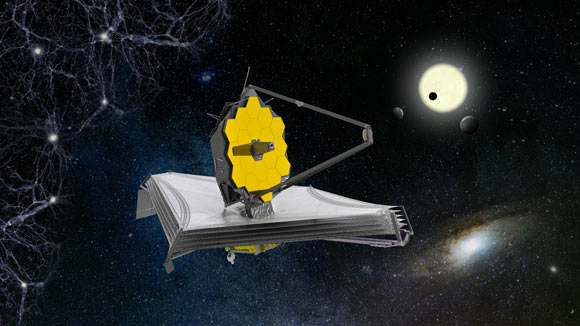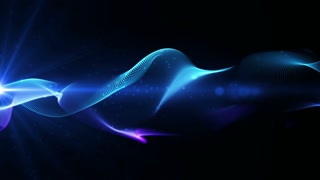Webb Telescope’s Sunshield Fully Deployed
Jan 5, 2022 by News Staff / Source
The Webb team has successfully completed tensioning for the five layers of the observatory’s kite-shaped sunshield.

An artist’s impression of the James Webb Space Telescope. Image credit: ESA.
The five-layered sunshield of the NASA/ESA/CAS James Webb Space Telescope — about the size of a tennis court at full size — was folded to fit inside the payload area of an Arianespace Ariane 5 rocket’s nose cone prior to launch.
Each plastic sheet is about as thin as a human hair and coated with reflective metal, providing protection on the order of more than SPF 1 million.
Together, the five layers reduce exposure from the Sun from over 200 kilowatts of solar energy to a fraction of a watt.
The sunshield will reach a maximum of approximately 383 K (110 degrees Celsius, 230 degrees Fahrenheit), while keeping Webb’s scientific instruments cold at a minimum of approximately 36 K (minus 237.15 degrees Celsius, minus 395 degrees Fahrenheit) — cold enough to see the faint infrared light that the telescope seeks to observe.
“This is the first time anyone has ever attempted to put a telescope this large into space,” said Dr. Thomas Zurbuchen, associate administrator for the Science Mission Directorate at NASA Headquarters.
“Webb required not only careful assembly but also careful deployments. The success of its most challenging deployment — the sunshield — is an incredible testament to the human ingenuity and engineering skill that will enable Webb to accomplish its science goals.”
“Unfolding Webb’s sunshield in space is an incredible milestone, crucial to the success of the mission,” said Dr. Gregory Robinson, Webb’s program director at NASA Headquarters.
“Thousands of parts had to work with precision for this marvel of engineering to fully unfurl. The team has accomplished an audacious feat with the complexity of this deployment — one of the boldest undertakings yet for Webb.”
The unfolding and tensioning of the sunshield involved 139 of Webb’s 178 release mechanisms, 70 hinge assemblies, eight deployment motors, roughly 400 pulleys, and 90 individual cables totaling roughly 400 m (0.25 mile) in length.
“The membrane tensioning phase of sunshield deployment is especially challenging because there are complex interactions between the structures, the tensioning mechanisms, the cables and the membranes,” said Webb sunshield manager Dr. James Cooper, a researcher at NASA’s Goddard Space Flight Center.
“This was the hardest part to test on the ground, so it feels awesome to have everything go so well today. The Northrop and NASA team is doing great work, and we look forward to tensioning the remaining layers.”
“The sunshield is remarkable as it will protect the telescope on this historic mission,” said Dr. Jim Flynn, sunshield manager at Northrop Grumman, NASA’s primary contractor for Webb.
“This milestone represents the pioneering spirit of thousands of engineers, scientists, and technicians who spent significant portions of their careers developing, designing, manufacturing, and testing this first-of-its-kind space technology.”
_____
This article is based on text provided by the National Aeronautics and Space Administration.
http://www.sci-news.com/astronomy/webb-sunshield-10429.html?utm_source=feedburner&utm_medium=email
Thanks to: http://www.sci-news.com
Jan 5, 2022 by News Staff / Source
The Webb team has successfully completed tensioning for the five layers of the observatory’s kite-shaped sunshield.

An artist’s impression of the James Webb Space Telescope. Image credit: ESA.
The five-layered sunshield of the NASA/ESA/CAS James Webb Space Telescope — about the size of a tennis court at full size — was folded to fit inside the payload area of an Arianespace Ariane 5 rocket’s nose cone prior to launch.
Each plastic sheet is about as thin as a human hair and coated with reflective metal, providing protection on the order of more than SPF 1 million.
Together, the five layers reduce exposure from the Sun from over 200 kilowatts of solar energy to a fraction of a watt.
The sunshield will reach a maximum of approximately 383 K (110 degrees Celsius, 230 degrees Fahrenheit), while keeping Webb’s scientific instruments cold at a minimum of approximately 36 K (minus 237.15 degrees Celsius, minus 395 degrees Fahrenheit) — cold enough to see the faint infrared light that the telescope seeks to observe.
“This is the first time anyone has ever attempted to put a telescope this large into space,” said Dr. Thomas Zurbuchen, associate administrator for the Science Mission Directorate at NASA Headquarters.
“Webb required not only careful assembly but also careful deployments. The success of its most challenging deployment — the sunshield — is an incredible testament to the human ingenuity and engineering skill that will enable Webb to accomplish its science goals.”
“Unfolding Webb’s sunshield in space is an incredible milestone, crucial to the success of the mission,” said Dr. Gregory Robinson, Webb’s program director at NASA Headquarters.
“Thousands of parts had to work with precision for this marvel of engineering to fully unfurl. The team has accomplished an audacious feat with the complexity of this deployment — one of the boldest undertakings yet for Webb.”
The unfolding and tensioning of the sunshield involved 139 of Webb’s 178 release mechanisms, 70 hinge assemblies, eight deployment motors, roughly 400 pulleys, and 90 individual cables totaling roughly 400 m (0.25 mile) in length.
“The membrane tensioning phase of sunshield deployment is especially challenging because there are complex interactions between the structures, the tensioning mechanisms, the cables and the membranes,” said Webb sunshield manager Dr. James Cooper, a researcher at NASA’s Goddard Space Flight Center.
“This was the hardest part to test on the ground, so it feels awesome to have everything go so well today. The Northrop and NASA team is doing great work, and we look forward to tensioning the remaining layers.”
“The sunshield is remarkable as it will protect the telescope on this historic mission,” said Dr. Jim Flynn, sunshield manager at Northrop Grumman, NASA’s primary contractor for Webb.
“This milestone represents the pioneering spirit of thousands of engineers, scientists, and technicians who spent significant portions of their careers developing, designing, manufacturing, and testing this first-of-its-kind space technology.”
_____
This article is based on text provided by the National Aeronautics and Space Administration.
http://www.sci-news.com/astronomy/webb-sunshield-10429.html?utm_source=feedburner&utm_medium=email
Thanks to: http://www.sci-news.com






 Sat Mar 23, 2024 11:33 pm by globalturbo
Sat Mar 23, 2024 11:33 pm by globalturbo

